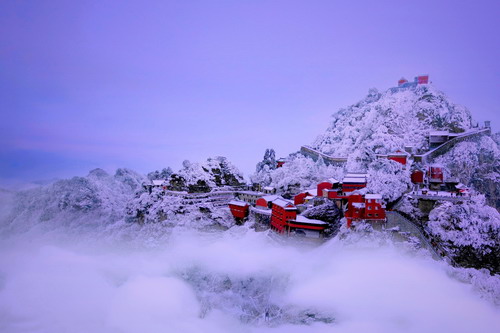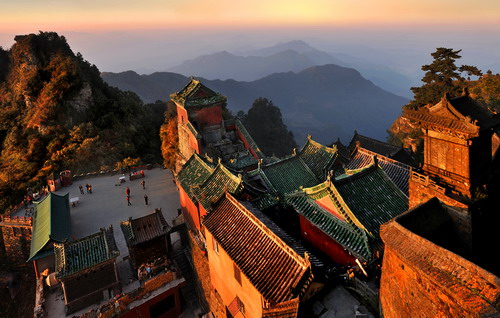Wudang Mountain
- Source: Hubei Provincial People's Government
- 08/17/2022 11:27
- 0 299
Wudang Mountain, in the northwest of Hubei province, is perhaps the best known of China's Taoist holy mountains. It was listed by UNESCO as a World Cultural Heritage Site in 1994.
The mountain has several main tourist attractions, covering an area of 300 square kilometers. From afar, the scenery resembles a beautiful, traditional Chinese landscape painting.
Wudang Mountain is famous for its perfect combination of natural and cultural scenery. It is also renowned for its magnificent ancient buildings, profound traditional Taoist culture and Wudang kungfu.

natural beauty
Wudang Mountain is beautiful all year round. In spring, the area is filled with flowers; in summer, the mist envelops; in autumn, oranges turn yellow and the smell of sweet-scented osmanthus fills the air; in winter, heavy snow covers the mountain like a white blanket.
Tianzhu Peak, the main peak, 1,612 meters above the sea level, is just like a pilar supporting the sky. Around Tianzhu Peak are 72 peaks, 36 rocky cliffs, 24 streams, 3 pools, 9 springs and 10 lakes.
Wudang Mountain has rich plant resources. About 600 of the 1,800 medicinal herbs recorded in Compendium of Materia Medica compiled by the Ming Dynasty (1368-1644) scientist Li Shizhen can be found in the area.

ancient building complex
A sprawling ancient building complex in the Wudang Mountain was founded in the heyday of the Tang Dynasty (AD 618-907), but reached its zenith during the Ming Dynasty, when Emperor Zhu Di sent some 300,000 workers in 1412 who spent 12 years to finish the sacred site.
The impetus for such imperial glamour originated in legends that say the prince of Pure Pleasure State came to Wudang Mountain to nurture his will and power. He has been worshipped ever since. Most of the buildings contain stories about him, including Pure Pleasure Palace built in the ancient city of Junzhou.
The buildings are located in a 70-km-long area from the Pure Pleasure Palace in the ancient city of Junzhou to the Golden Hall at the top of Tianzhu Peak.
At present, the well-preserved buildings include Xuanyue Archway, Yuanhe Taoist Temple, Yuzhen Palace, Yuxu Palace, Fuzhen Taoist Temple, Zixiao Palace, Taihe Palace and Golden Hall. The Golden Hall, situated on top of Tianzhu Peak and built in 1416, is the most famous of the buildings.
The complex was designed to fit the Taoist principle of harmony between man and nature. Its buildings are cited as a museum of ancient Chinese design and thought. A thousand years of lightning, storms and winds only make them more magnificent.
The buildings have won wide acclaim in architectural circles. Two United Nations experts wrote that they think the Wudang Mountains are among the beautiful places on earth due to its exquisite architectural design.

Taoist culture
The history of Taoism at Wudang Mountain can be traced back about 2,000 years. It began to prosper in the Tang and Song dynasties, and reached its heyday in the Ming Dynasty. Taoism witnessed a decline in the ensuing Qing Dynasty, but it was revitalized after the founding of New China in 1949.
Taoist ritual activities follow a set of procedures handed down through generations of Taoist priests. The priests recite ancient scriptures and play Taoist music, following a centuries-old formula. Taoist music has been extensively studied by scholars and experts.
Tickets of the Wudang Mountain Tourism Area:
Entrance tickets for the entire scenic area (excluding Purple Heaven Palace and Golden Summit) cost 140 yuan.
Tickets for the Purple Heaven Palace and the Golden Summit are 15 yuan and 20 yuan, respectively. The sightseeing bus costs 70 yuan and the cable car 150 yuan round-trip -- 80 yuan for the ride up, 70 yuan for the trip down.
Useful telephone numbers:
Ticket center: 86-719-5665396
Inquiries: 86-719-5668567
Complaints: 86-719-5689187
Preferential treatment:
1. Entrance tickets for students (with a student ID card), children 1.2-1.5 meters tall, and people 60-69 years age cost 105 yuan.
2. Entrance is free for children under 1.2 meters tall, and for people 70 years or older. The elderly also get bus tickets half-price.